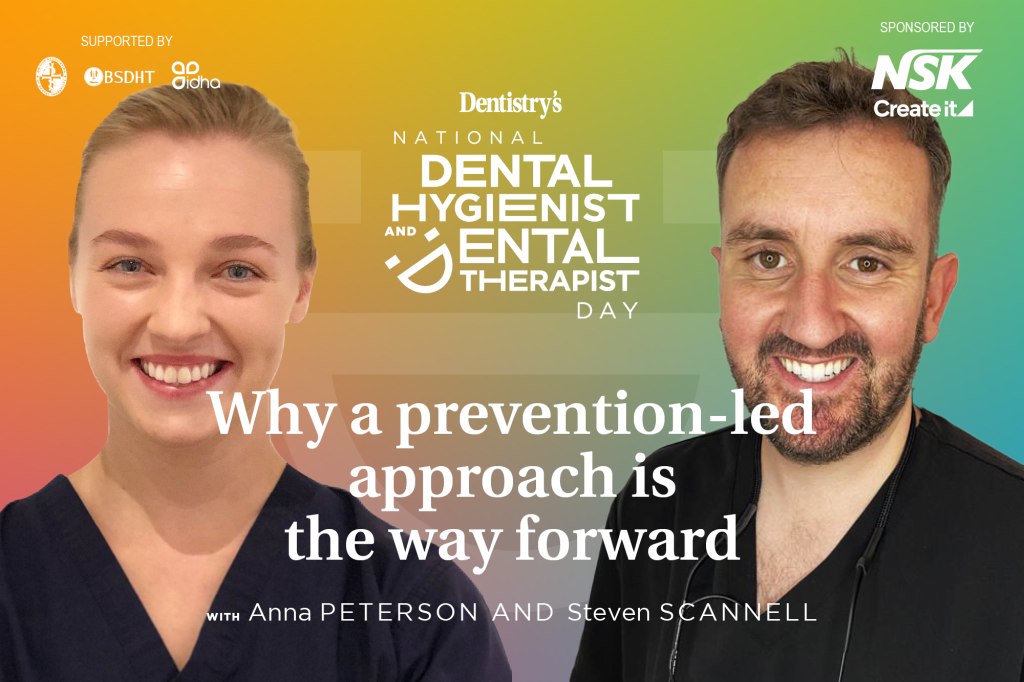
Steven Scannell and Anna Peterson discuss what preventive dentistry looks like and how it creates both greater results and better patient engagement.
Steven Scannell, dental hygienist
A prevention-led approach to dentistry is to help maintain a patient’s longterm oral health, and where possible try to keep the need for invasive treatment to a minimum. This involves focusing on educating patients during regular visits to the dental hygienist and during examinations with a dental therapist or dentist.
If treatment is carried out without a prevention-led approach then the outcome of that treatment is more likely to be unsuccessful.
There are many simple ways practices can implement a prevention-led approach for their patients. Encouraging regular visits with the dental hygienist or therapist to monitor their gum health, oral hygiene routine and screen for any dental disease. During these visits the hygienist or therapist can carry out regular plaque scores, give dietary advice and apply fluoride varnish and fissure sealants where deemed necessary.
Education is vital
Education during these visits is another vital part of any dental appointment. Giving patients simple and easy to understand information to improve their oral health is key. As we know, there are four main contributing factors when it comes to dental decay and these are tooth surface, time, fermentable carbohydrates (sugar) and plaque. So if patients are educated on how to effectively remove that plaque from their teeth, and how to limit sugar intake in their diet then that’s two of those risk factors for dental decay reduced.
I feel that a prevention-led approach to treating patients is the way forward and the education that we provide is extremely important. This all helps to enable positive behavioural changes which leads to a reduction in their treatment needs.
With this education, patients will then have the knowledge to continue to improve their oral and general health. From my personal experience following the prevention-led approach, I have found that my treatments have been more successful and patients have responded very well to this approach.
Anna Peterson, dental therapist
If you speak to anyone in dentistry, they will tell you prevention is key. We all know how important prevention is for our patients. The success of any cosmetic treatment can be determined by how well the patient looks after their oral health. However, when it comes down to the treatment fees and appointment times, oral hygiene instruction/oral health education is usually the cheapest treatment and shortest appointment time, if an appointment at all.
Oral hygiene instruction (OHI) is quite often integrated into an examination/hygiene appointment. This is important, and by no means am I advising practices stop doing that, but as a practice we have changed how we deliver OHI. We now have 60-minute appointments for oral hygiene instruction in which we spend a lot of time with our patients showing them exactly what tools are needed to remove dental plaque.
It takes five minutes to show a patient an interdental brush and an effective toothbrushing technique, and maybe for some patients this is all that is needed. However, often I find that patients need more time. In our oral hygiene appointments, we will disclose the mouth and look together at where the dental plaque bacteria are. We will then look at how to remove the plaque – I will show them with their own toothbrush or the Oral-B test drive.Then I will get the patient to use the brush in front of me to remove the disclosed plaque.
‘Greater results’
Nine times out of 10 they will not remove the plaque the first time, even with the visual aid of disclosing. We then work together by showing them the most effective technique, again getting the patient to have a go. It takes time to master the correct technique with toothbrushing, and once the patient has understood how to do it, the learnt skill is invaluable to them.
We also do the same process with interdental brushes, floss and water flossers, and they will potentially require removal of built-up hard deposits to get an interdental aid through. I use the NSK Various Combi Pro unit to do this as its gentle for patients that may have inflammation or sensitivity as it uses a combination of ultrasonic scaling and air polishing.
We first implemented this approach while working with a periodontist who completed the consultation and advised the patient to have multiple 60-minute oral hygiene instruction appointments with the dental therapist or dental hygienist. After achieving a below 20% plaque score and a 0% plaque presence in areas of pocketing, the patient could return to the periodontist for treatment. This worked fantastically well, and treatment was very successful. As a practice we decided to use this prevention led approach with all our patients.
This treatment is completed by the dental hygienist/dental therapist and, for myself, I see greater results with my patients and an increased motivation and understanding. I recommend that all practices implement this prevention led approach. We charge accordingly, we see better results and we improve patients’ oral health.
With thanks to our sponsor, NSK.
Celebrating National Dental Hygienist and Dental Therapist Day:
- Why everyone wins when you utilise dental therapists
- Supportive care and maintenance of dental implants
- Happy National Dental Hygienist and Dental Therapist Day!
- The evolution of dental hygienists and dental therapists
- Implementing a therapy-led model in practice
- Empowering dental hygienists and dental therapists.
- Introducing National Dental Hygienist and Dental Therapist Day.
Follow Dentistry.co.uk on Instagram to keep up with all the latest dental news and trends.


